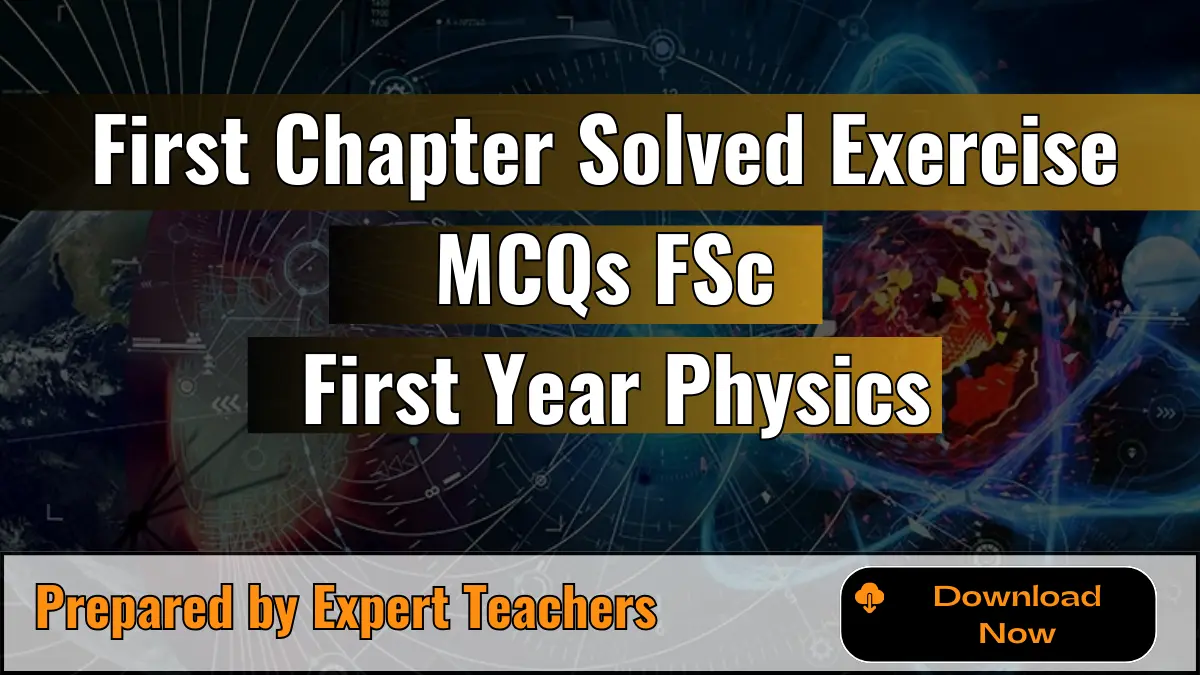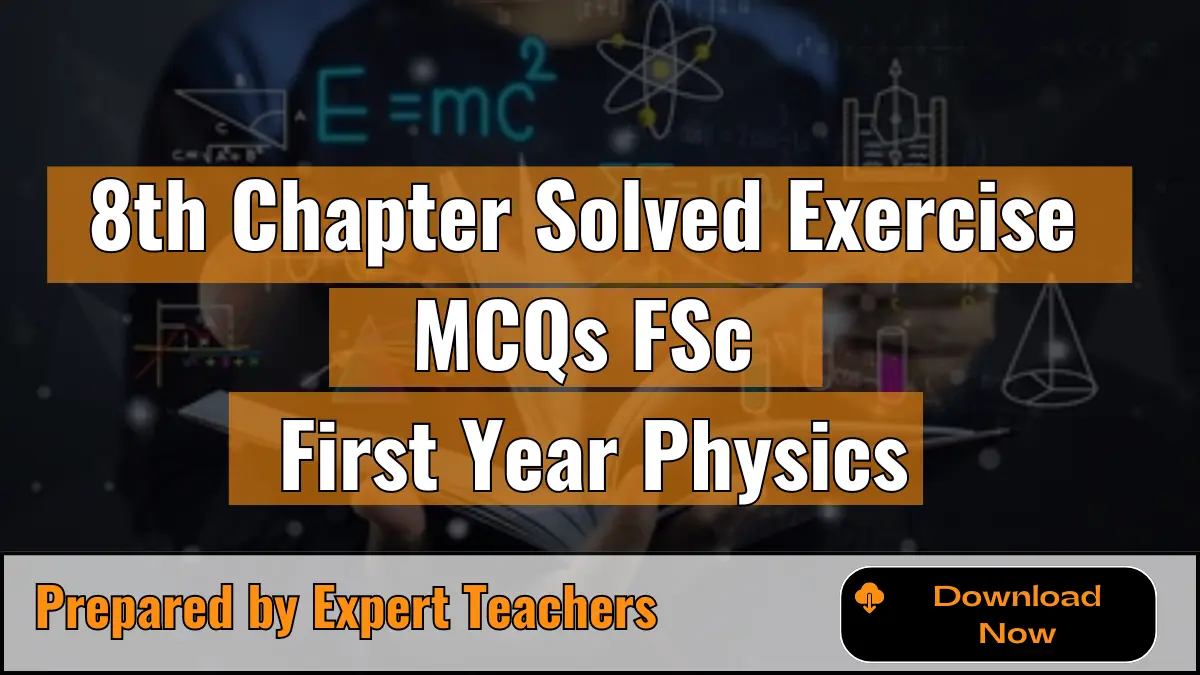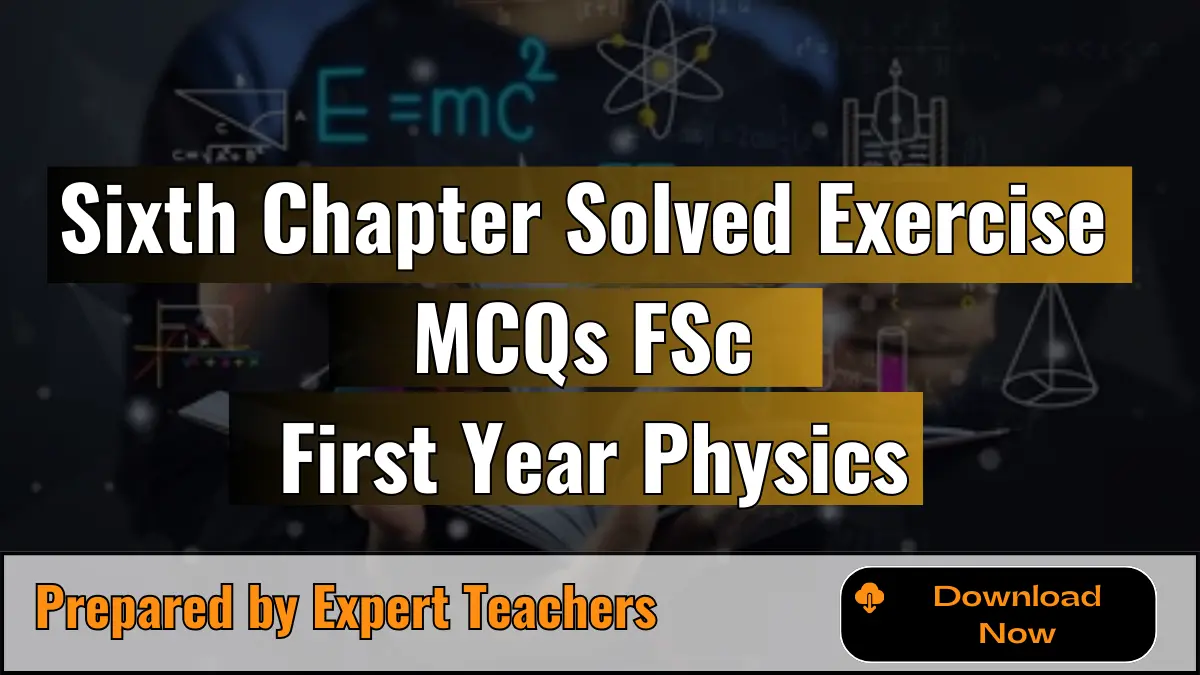Second Chapter Solved Exercise MCQs Of FSc First Year Physics
Second Chapter Solved Exercise MCQs of FSc First Year Physics is helpful for FSc students. It includes multiple-choice questions from the first chapter, each with a clear answer and explanation. This resource is perfect for reviewing key ideas, practicing for exams, and improving your understanding of physics concepts.
Second chapter solved MCQs with explanation
1. Pick out the scalar quantity
(a) Power
(b) Torque
(c) Acceleration
(d) Impulse
Explanation: Option (a) is correct. Power is a scalar quantity as it is defined as the rate of doing work, which is a scalar.
2. The addition of vectors obeys
(a) Commutative law
(b) Associative law
(c) Distributive law
(d) Both (a) and (b)
Explanation: Option (d) is correct. Vector addition follows both the commutative and associative laws.
3. Maximum number of components of a vector can be
(a) One
(b) Two
(c) three
(d) four
Explanation: Option (c) is correct. A vector can have three components in three-dimensional space.
4. Two forces act together on an object. The magnitude of their resultant force is minimum when the angle between them is
(a) 0°
(b) 90°
(c) 180°
(d) 45°
Explanation: Option (c) is correct.The resultant force is minimal when the angle between two forces is 180° because they act in opposite directions.
5. Magnitude of resultant vector of 6N and 8N which are perpendicular to each other is:
(a) 14 N
(b) 10 N
(c) 28 N
(d) 2 N
Explanation: Option (b) is correct.The magnitude of the resultant of two perpendicular vectors can be found using the Pythagorean Theorem.
6. Two vectors are A = 3i + 2j – k and B = -i + 3j + 2k. Then
(a) A is perpendicular to B
(b) B is negative vector of A
(c) Both a & b
(d) B is perpendicular to A
Explanation: Option (a) is correct. A and B are perpendicular because their dot product is zero.
7.If a force of 5N is applied parallel to moment arm of 5m, then torque is
(a) 25 Nm
(b) 5 Nm
(c) 10 Nm
(d) 0 Nm
Explanation: Option (a) is correct. The torque is calculated as the product of the force and the perpendicular distance from the axis of rotation. In this case, the force and the moment arm are parallel, so the perpendicular distance is simply the length of the moment arm. Therefore, the torque is 5N * 5m = 25 Nm.
8. If A·B=0 then A×B = ______
(a) 0
(b) 1
(c) AB
(d) |A||B|
Explanation: Option (a) is correct.If the dot product of two vectors is zero, they are perpendicular.
9. If A×B=0, then angle between vectors is
(a) 0°
(b) 90°
(c) 180°
(d) 45°
Explanation: Option (a) is correct. If the cross product of two vectors is zero, they are parallel.
10. The magnitude of product vector C (A×B) = 2 is equal to
(a) The sum of magnitudes of A and B vectors
(b) Area of parallelogram
(c) Product of four sides
(d) Parameters of parallelogram
Explanation: Option (b) is correct. The magnitude of the cross product of two vectors is equal to the area of the parallelogram formed by them.
11. Which of the following is not a method of resolving or combining vectors?
(a) Graphical method
(b) Analytical method
(c) Component method
(d) Multiplication of vectors
Explanation: Option (d) is correct. Multiplication of vectors does not involve resolving or combining vectors.
12. Reversal process of vector addition is called
(a) Subtraction of a vector
(b) Division of a vector
(c) Multiplication of a vector by a negative number
(d) Multiplication of a vector by a scalar
Explanation: Option (c) is correct.Reversing a vector is equivalent to multiplying it by -1.
13. A vector A when rotated through an angle θ becomes vector B. Then A·B is equal to
(a) AB
(b) AB cos θ
(c) AB sin θ
(d) Change by 270°
Explanation: Option (b) is correct.The dot product of two vectors is AB cos θ.
14. The minimum number of vectors that can result in zero are
(a) 1
(b) 2
(c) 3
(d) 4
Explanation: Option (c) is correct.Three vectors can result in zero if they form a triangle.
15. Two forces F1 and F2 act along the same line. The magnitude of their resultant is maximum when the angle between them is
(a) 0°
(b) 90°
(c) 180°
(d) 270°
Explanation: Option (a) is correct. The resultant force is maximum when the angle between two forces is 0° because they act in the same direction.
16. If A·B gives some value then the vector A and B must be:
(a) Collinear
(b) Non-collinear
(c) In same plane
(d) In different planes
Explanation: Option (a) is correct.If the dot product of two vectors is non-zero, they must be collinear.
17. A vector must have _____ rectangular components.
(a) 1
(b) 2
(c) 3
(d) 4
Explanation: Option (c) is correct. A vector in three-dimensional space has three rectangular components.
18. What is the angle that the given vector makes with the x-axis? A = 2i + √3j
(a) 30°
(b) 45°
(c) 60°
(d) 120°
Explanation: Option (a) is correct. First Identify components: x=2, y=√3. Second, Use the formula θ=tan−1(y/x). Third,Calculate θ=tan−1(√3/2)and at last Find θ≈30∘.
19. If for two non-zero vectors A and B, A × B = 0, the vectors will be:
(a) Perpendicular
(b) parallel
(c) anti-parallel
(d) 60°
Explanation: Option (b) is correct. If the cross product of two vectors is zero, they are parallel.
20. Which one vector is not always a vector quantity?
(a) Gravitational Acceleration (g)
(b) Electric field
(c) Momentum
(d) Power
Explanation: Option (d) is correct. Power is a scalar quantity, not always a vector.







Leave a Reply